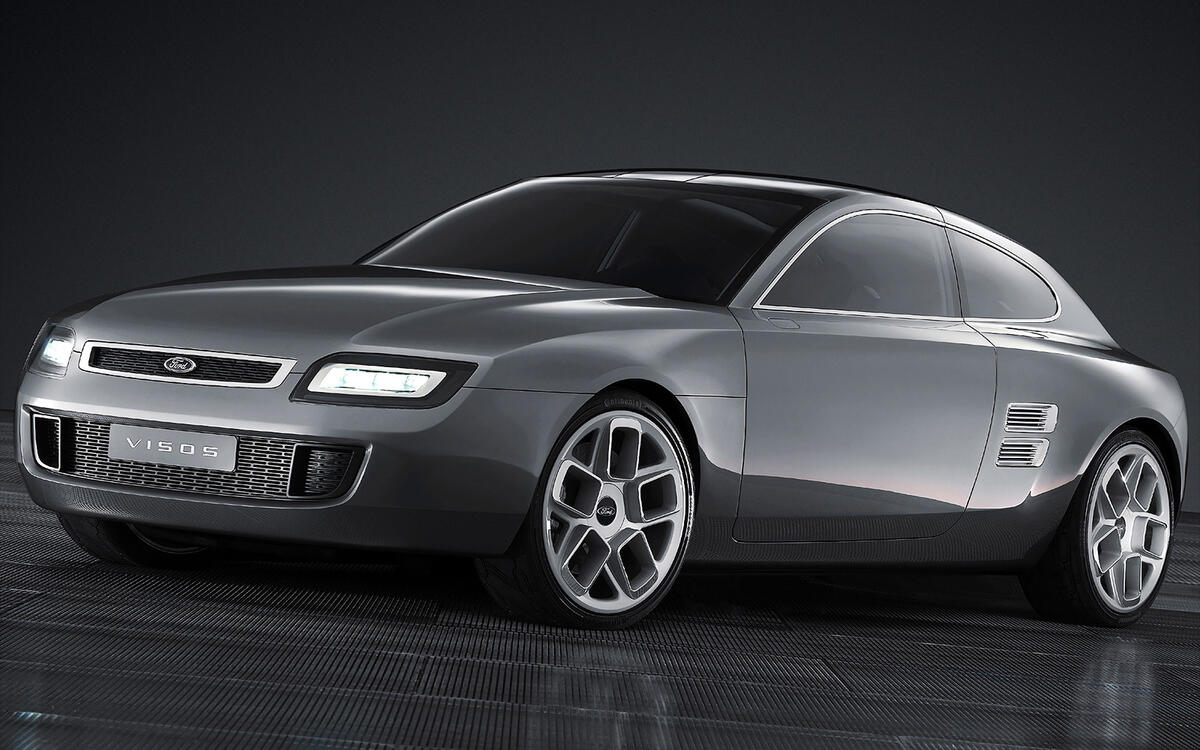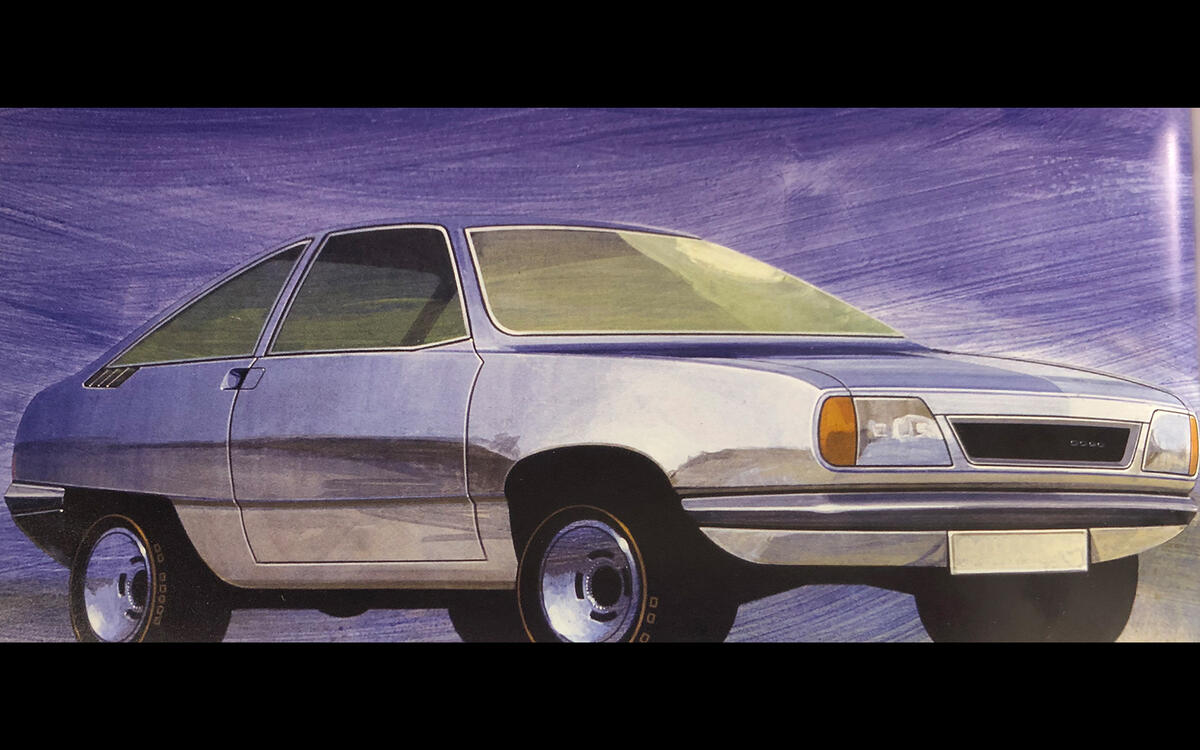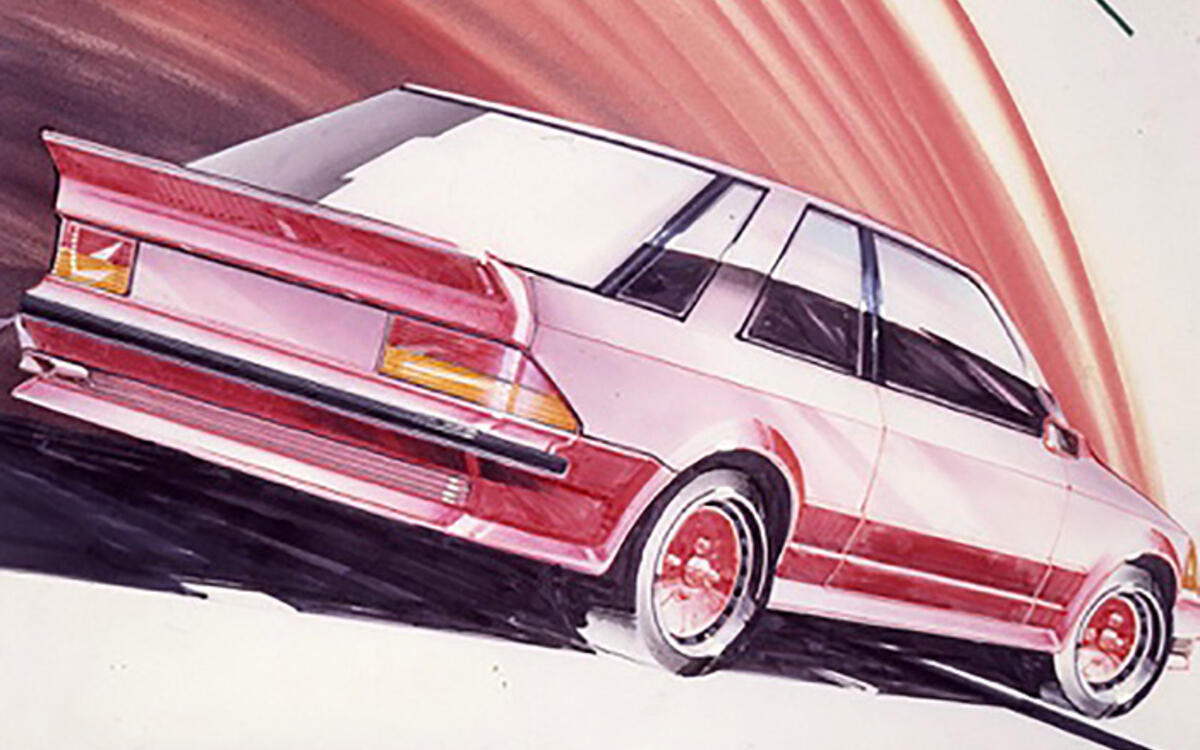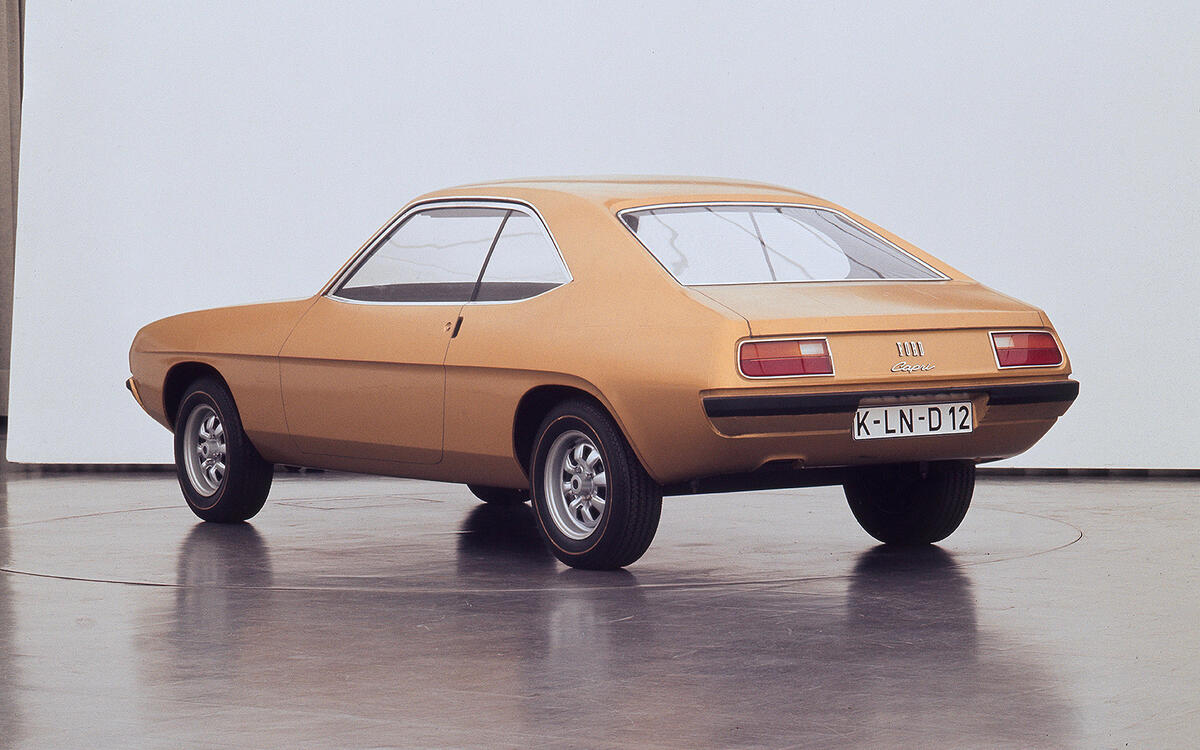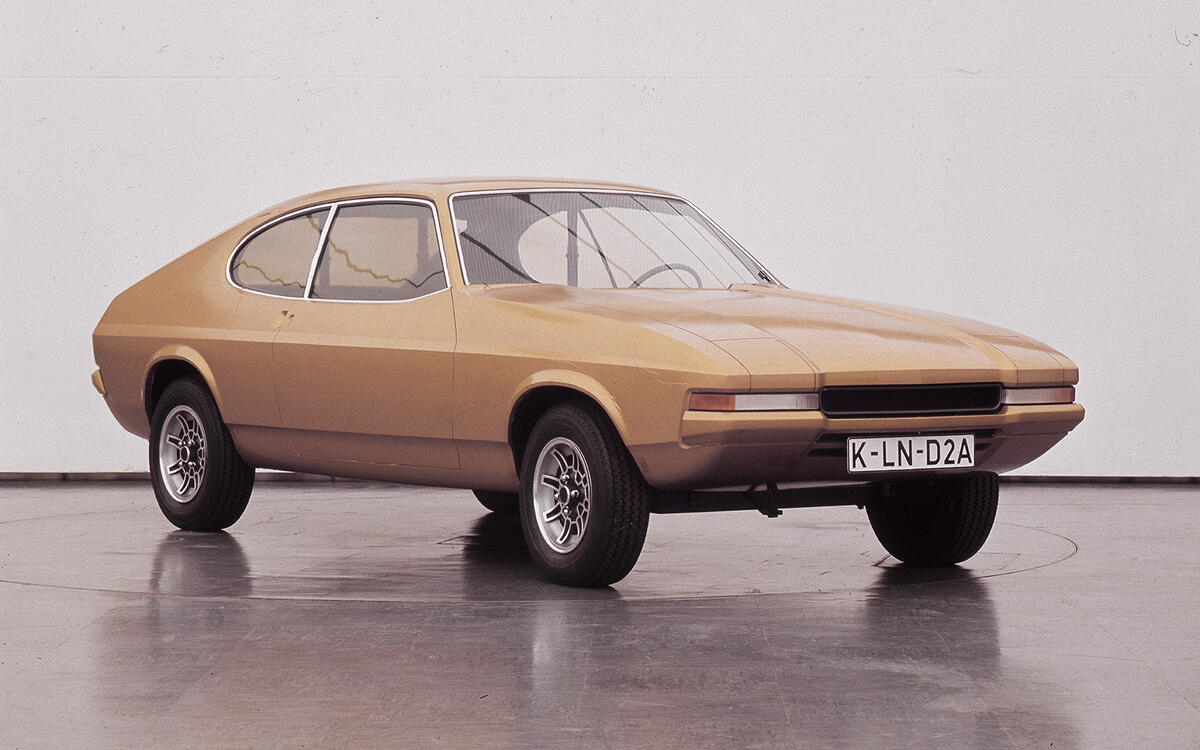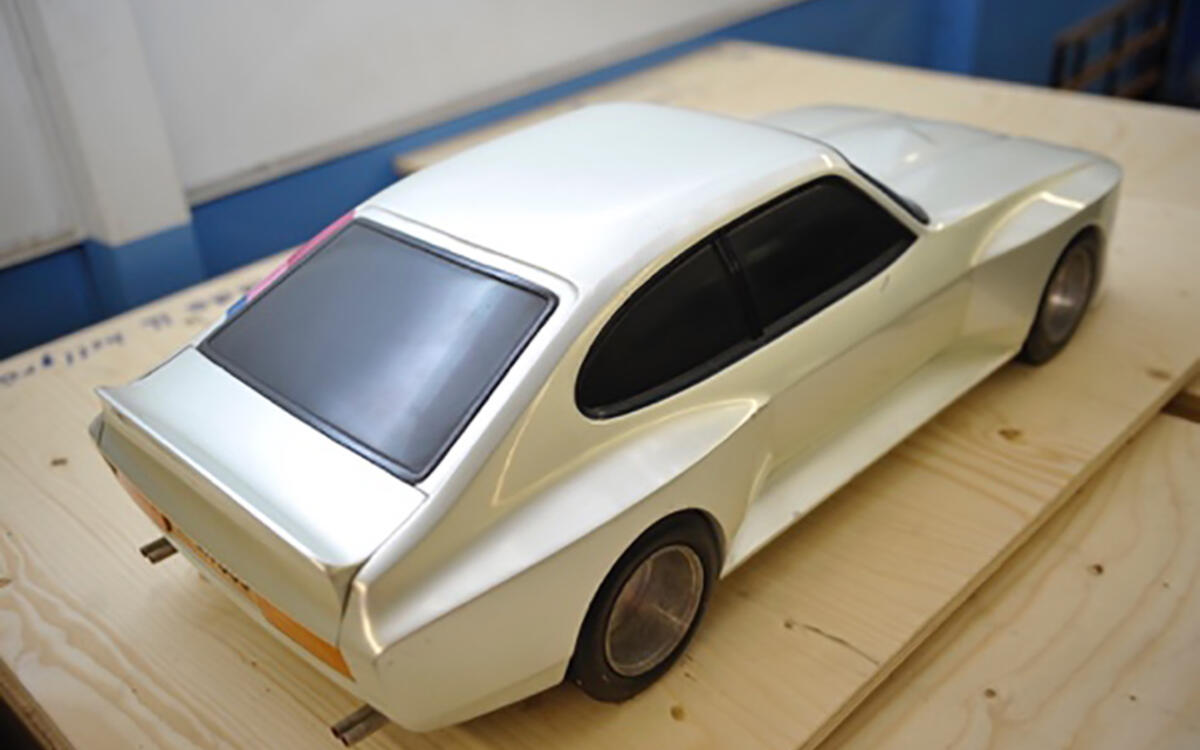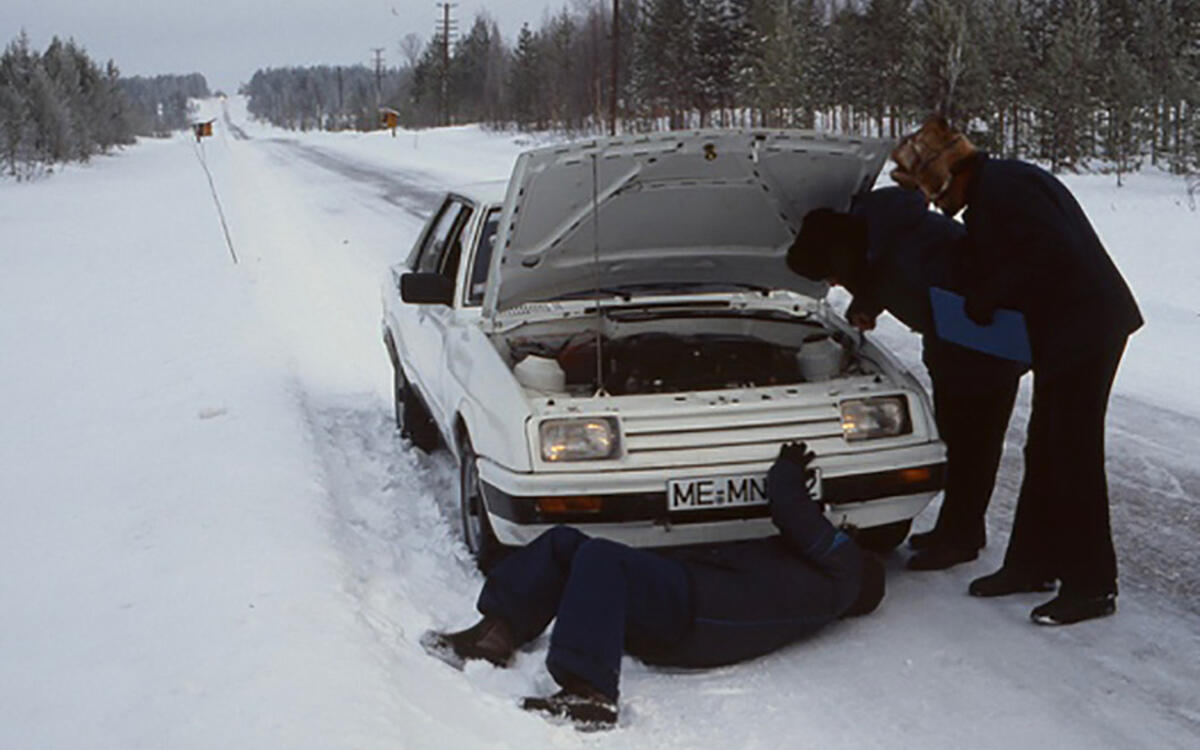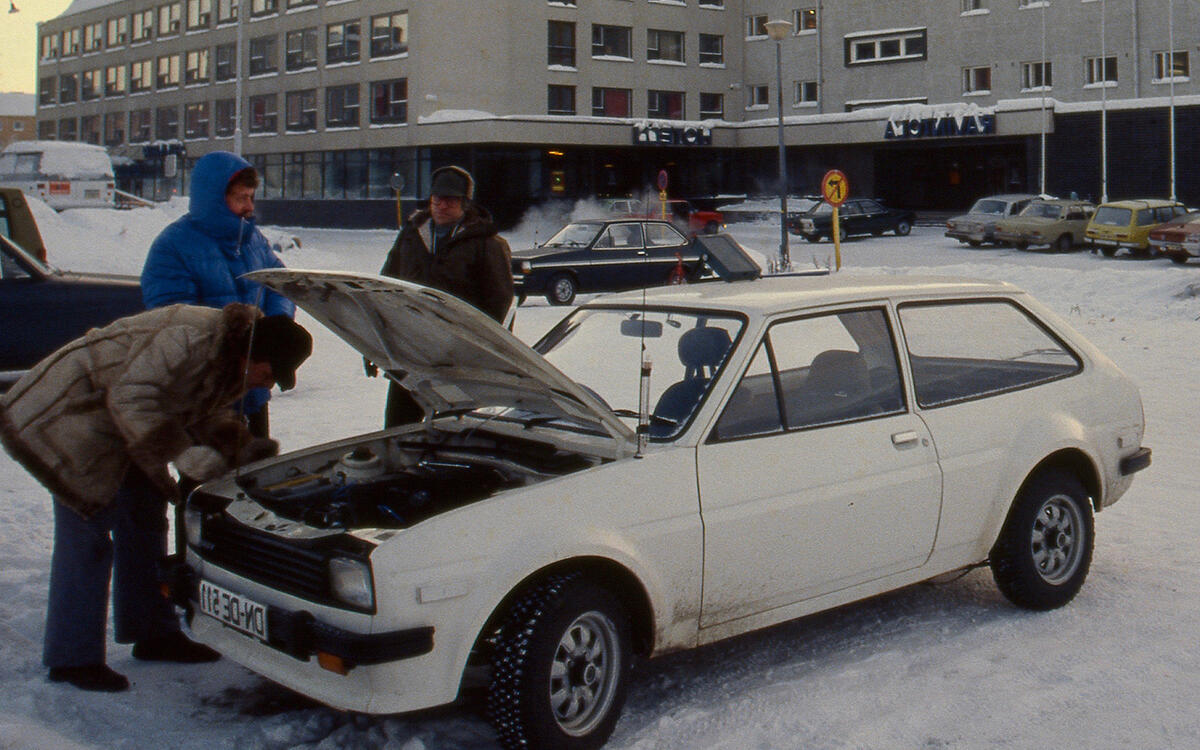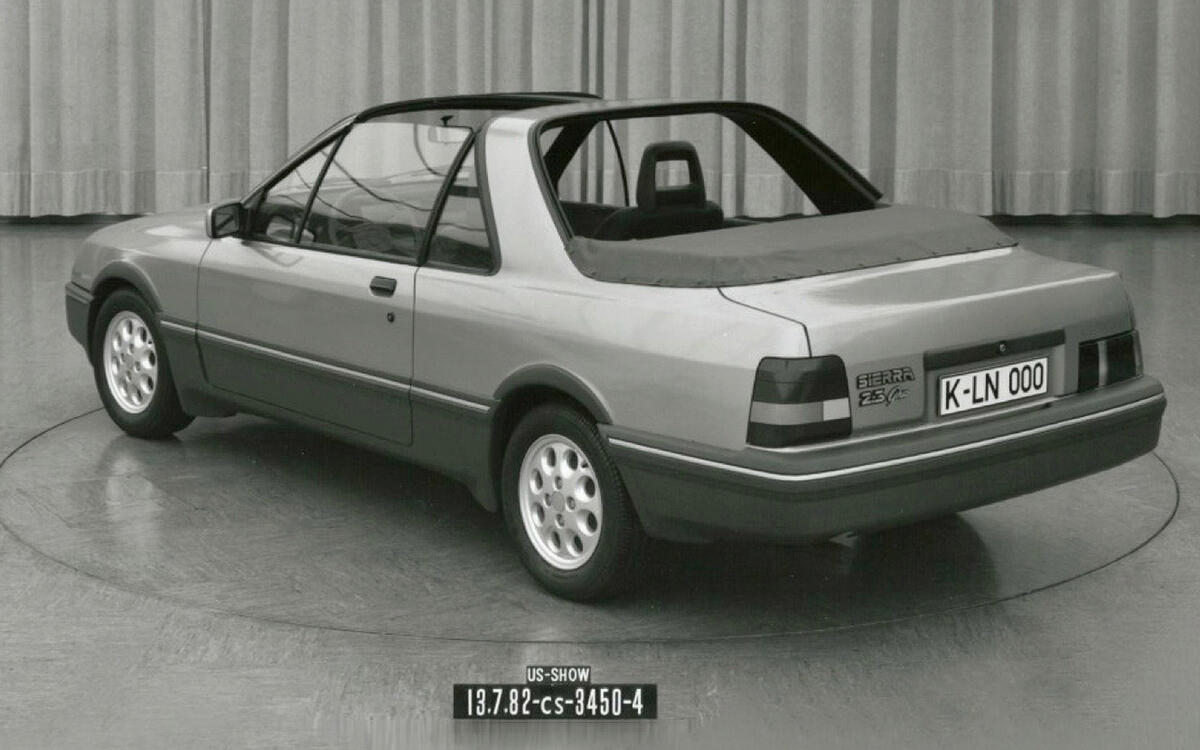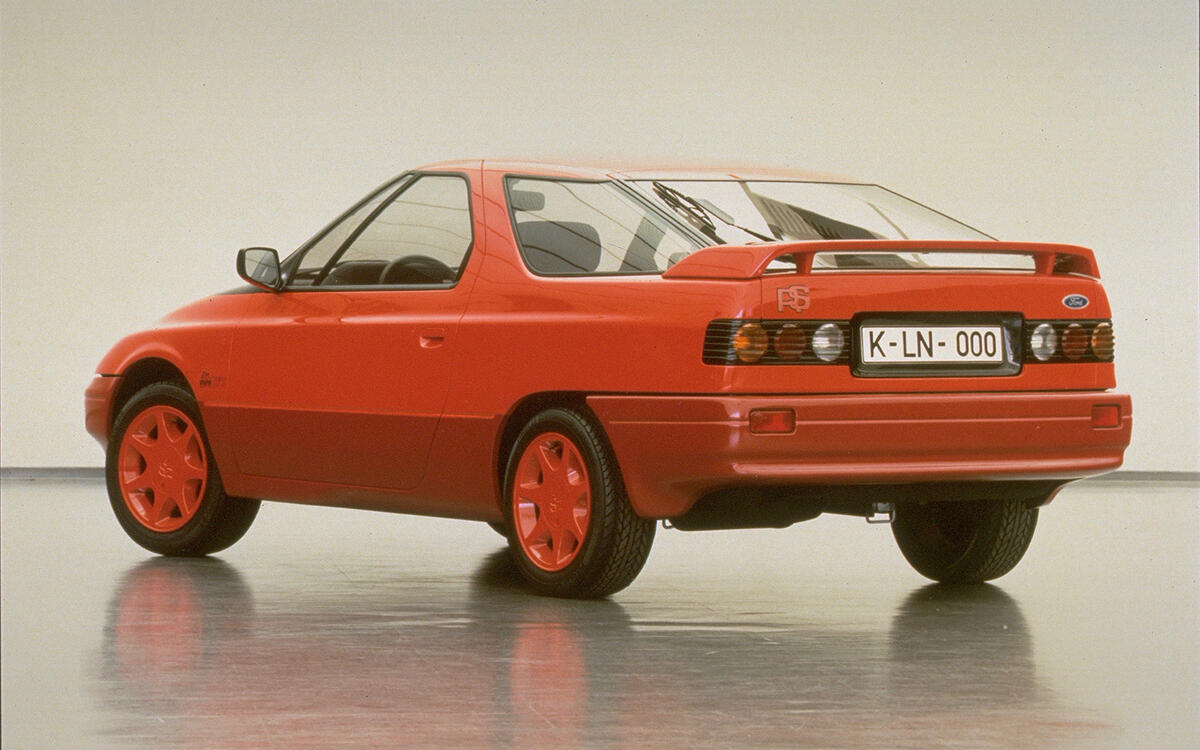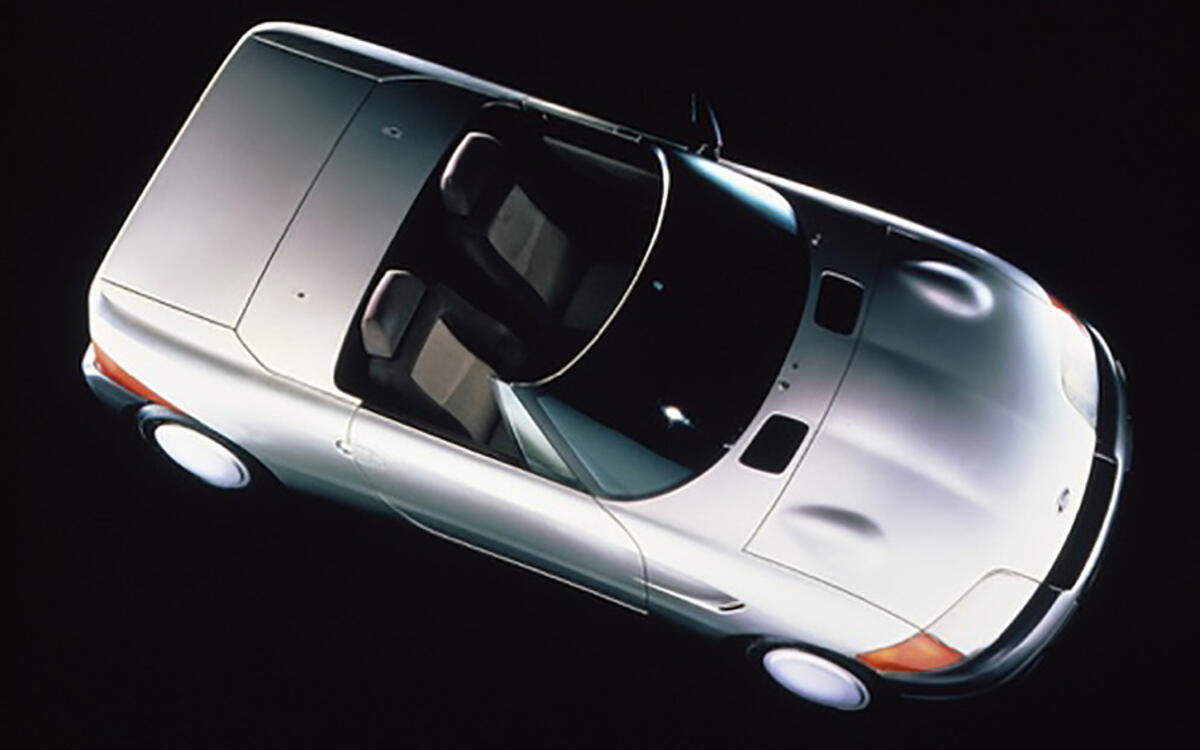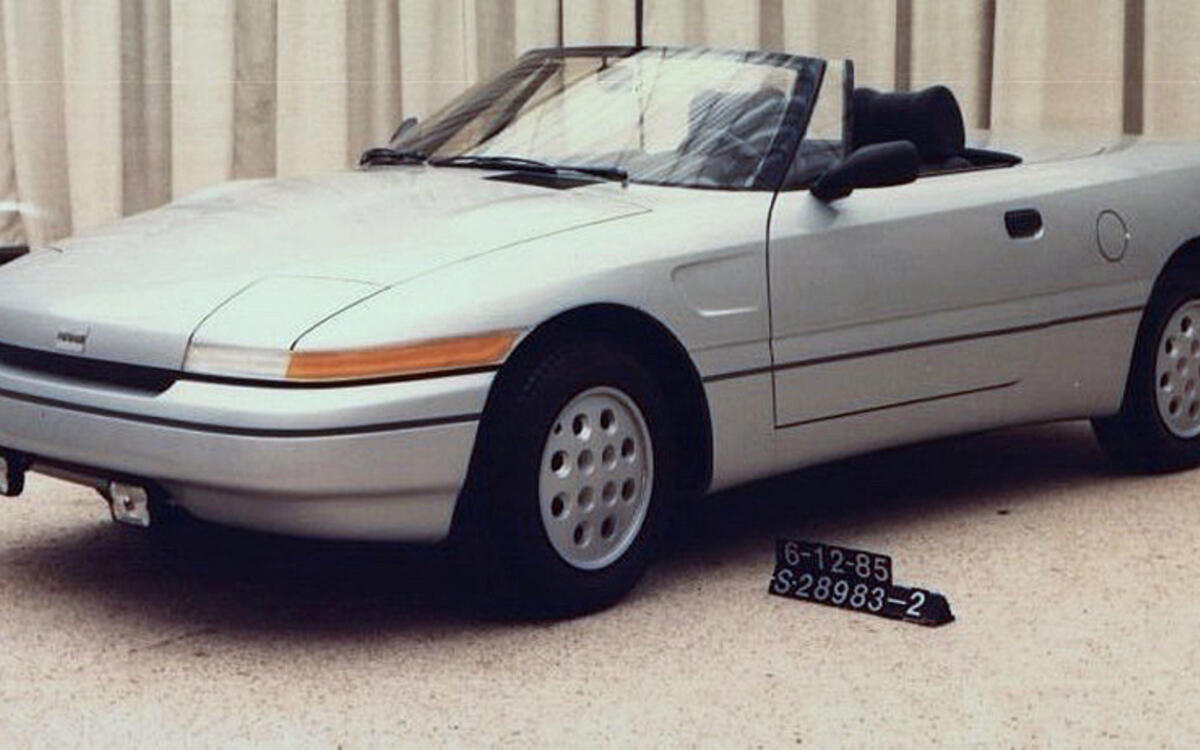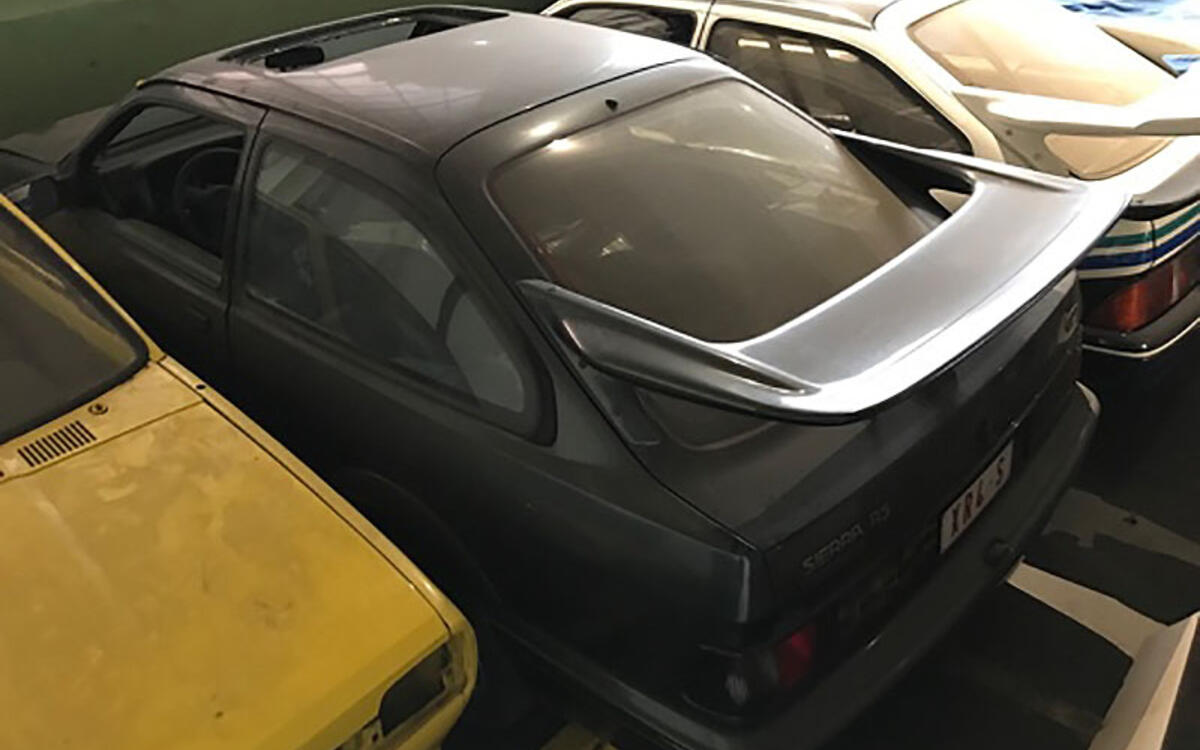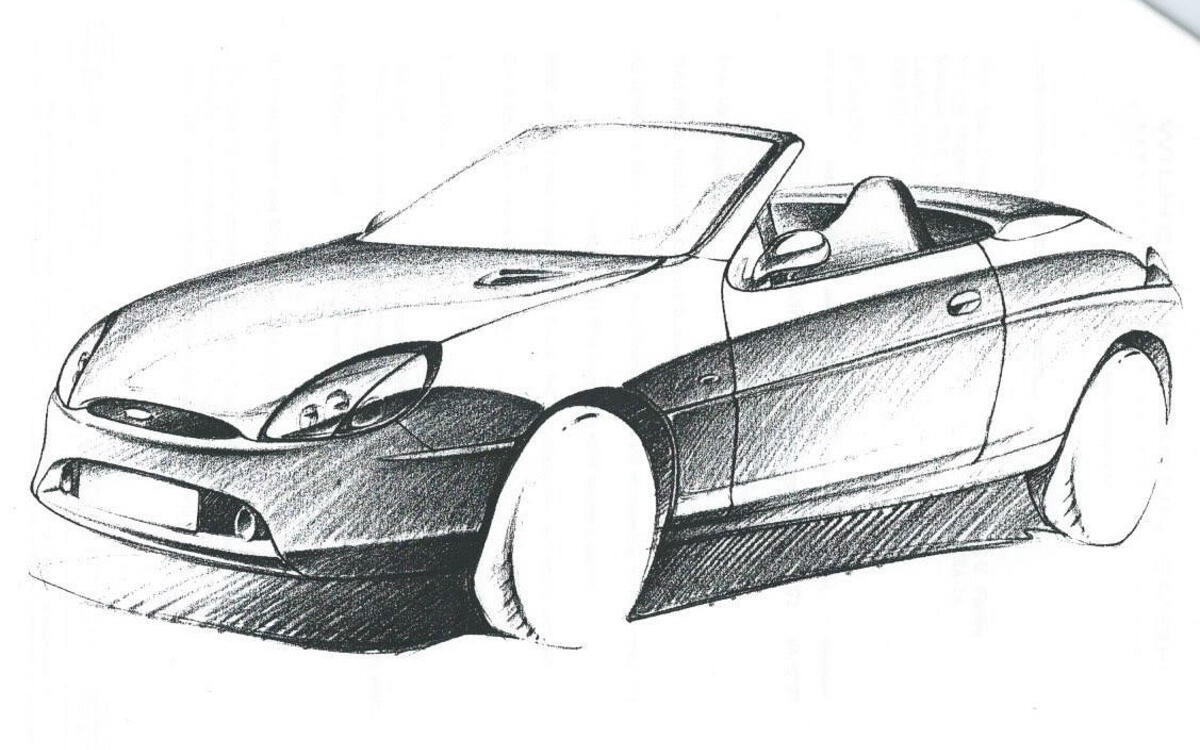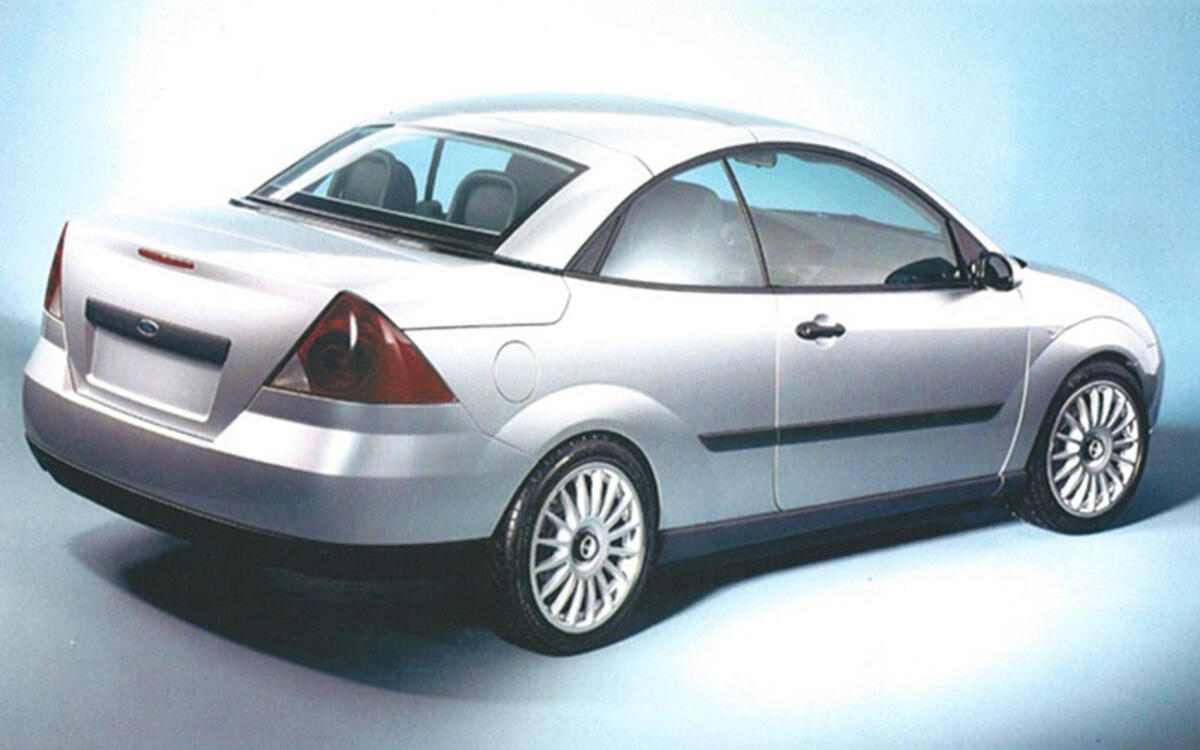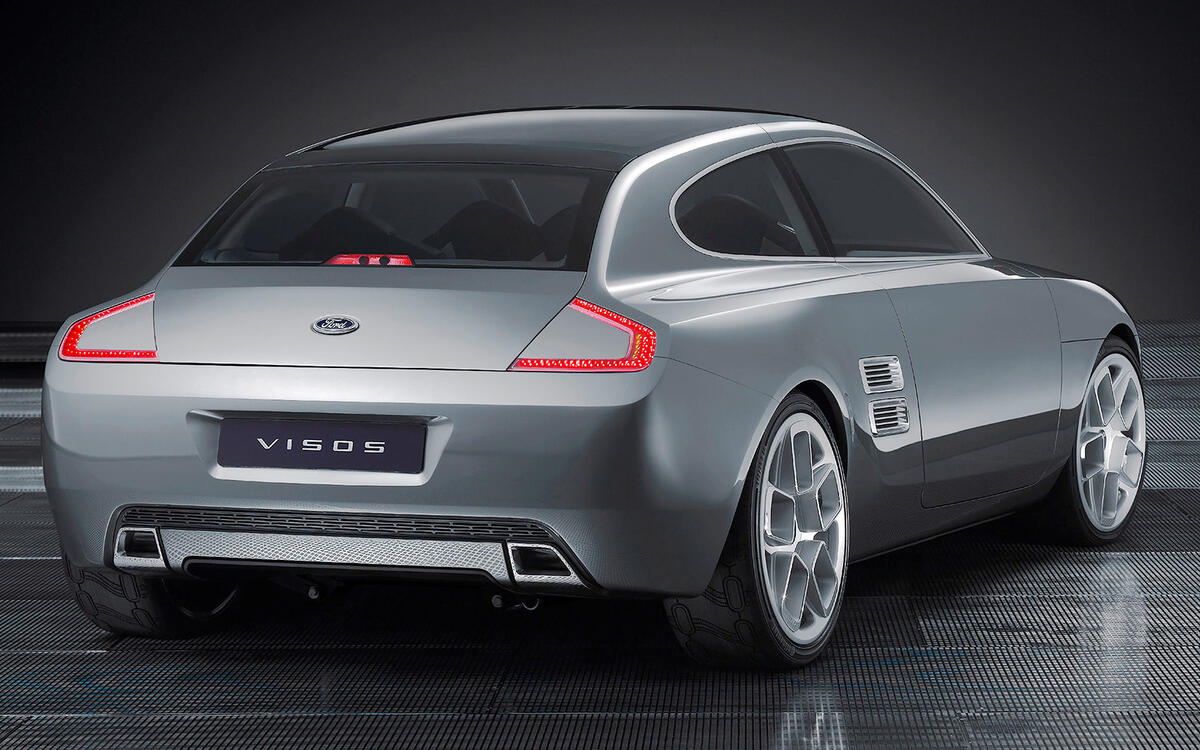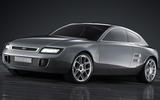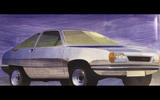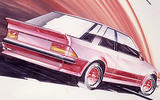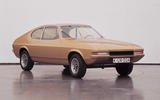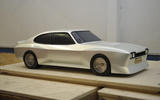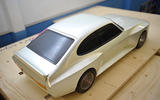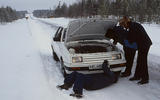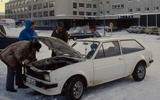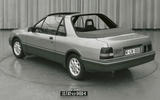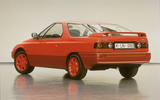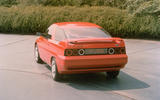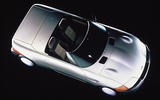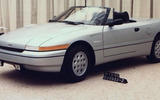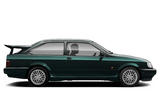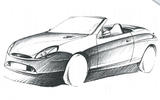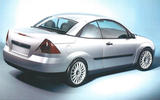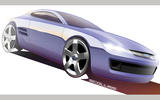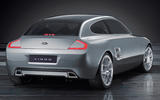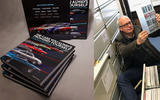 Slide of
Slide of
A new book called “The Cars You Always Promised Yourself” is a 50-year tale of Ford’s design, engineering and marketing.
It features Fords most memorable European cars, from the Capri and Sierra to the Puma and today’s Focus RS. It’s an insider’s story of how cars are designed, engineered and marketed, told through the lens of the more glamorous coupés and interesting RS cars.
Most of the images in the book have never been published before but the real stars are the secret cars that have, until now, never been seen before. Author and former Ford employee Steve Saxty was granted first-time access to Ford’s design archives and he takes up the story, describing ten automotive unicorns that feature in the book. Enjoy the ride:
 Slide of
Slide of
Escort Coupés
Ford of Britain had wanted to make an Escort Coupé in the late ‘60s but bosses in Detroit insisted on the Capri instead. The larger car’s success meant that a smaller 2+2 never happened, even when the game-changing Volkswagen Scirocco arrived. But Ford kept trying behind the scenes. Designer Patrick le Quément - who would later find fame at Renault - drew this early '70s car, complete with a Van Gough-inspired sky, but it was not to be.
Instead, the dramatic-looking Escort RS2000 of 1975 was the closest Ford got to such a speciality Escort.
 Slide of
Slide of
Escort Coupés
When the designers moved on to styling the 1981 Escort they didn’t stop trying to find novel ways to make a coupé out of it. Dutch designer Harm Lagaay proposed this Escort pseudo-coupé with three side windows; he would later go on to design great things like the BMW Z1 and various iconic Porsche models. Of course, the eventual solution was instead the XR3i, and the window treatment was reserved for the controversial XR4i that followed it.
An Escort Coupé was an itch that Ford tried to scratch right through the '70s and '80s. But as long as the Capri made money then it made sense to stick with the old car, even if competitors had downsized to Escort-sized coupés.
 Slide of
Slide of
Capri Mk 2
The original 1969 Capri was a huge hit and Ford quickly began working on its successor in 1971. This was one of two proposals shown to Ford chief Henry Ford II, a rather elegant and timeless-looking Capri II that could have still served as a retro-modern design several decades later. Designer Claude Lobo incorporated the classic ‘hockey-stick’, C-shaped side windows and D-shaped taillights.
 Slide of
Slide of
Capri Mk 2
But Henry wasn’t impressed and wanted something more modern and chose this competing design by Hans Muth. The most senior Ford still wasn’t happy with Muth’s front end design and its pop-up headlights. “That’s no Capri” he proclaimed and so the front of Lobo losing design was hastily grafted on. What’s amazing about these photos is their high-def sharpness. Fifty years ago someone was let loose with a Hasselblad 2¼-inch camera and these photos look as modern today as the cars look dated.
Finding these photos and reproducing them in the book was a treat after Ford’s designers annotated them with notes to show all the little tricks of their trade on the page.
 Slide of
Slide of
Capri RS2800
The RS2800 was an idea that flickered into life several times. In 1973 the legendary Advanced Vehicle Operations (AVO) group toyed with the idea of an RS2800 Granada – a ‘businessman’s express’ - but the car they really wanted to make was this RS Capri. It combined the old RS2600 Capri’s fuel-injection system with a larger engine and ultra-low sports suspension.
If the 175bhp Capri RS2800 had made production then it would have been the most powerful car Ford sold in Europe for another ten years until the Sierra Cosworth arrived.
 Slide of
Slide of
Capri RS2800
But the fuel crisis of 1974 hit and the Essex-based AVO closed. The German Ford Motorsport group revived the idea in 1975 and a drivable car was made, complete with a unique RS interior. Large-engined cars were still difficult to sell and so Ford chose to let customers buy the parts individually and build their own – or, as it’s called in the book, ‘RS in a box’.
Even then the idea wouldn’t die and the same car finally came to market in 1981 as the iconic Capri Injection. These photos show wide-arched wind tunnel model that Ford unearthed for me after 45 years in storage – it looked almost new. Possibly the most desirable car Ford never made; right car, wrong time.
 Slide of
Slide of
Frankenstein Fords
Today’s cars that get scooped by Autocar are often close to production and look like the real thing. But back in the ‘70s and ‘80s Ford and other car companies used to test out their new cars using grotesque-looking ‘mules’ such as these. In 1973, when Ford developed the original Fiesta, it didn’t have a front-wheel drive car to test the new car’s transmission. The solution was to buy ten Fiats 127s and then weld on the front of a Fiesta; crude but effective.
This Cortina is one of the early test mules for the Sierra, complete with the new car’s front end and rear suspension. It sat low at the back because it mated two cars that were never intended to go together. The police kept stopping test drivers thinking that something was wrong. The engineers' neat solution was to attach a camping trailer at the back and they were never troubled again.
 Slide of
Slide of
Frankenstein Fords
This picture is a mule for the 1981 Escort. The ‘Fiesta estate’ is a wonderful piece of disguise that houses all the running gear of the Escort underneath. I grew up being fascinated by such mutants but today much of the early development work is done digitally so we don’t see them like we used to and these cars are a charming throwback.
 Slide of
Slide of
Sierra Targa
The ill-fated XR4i lived for less than two years. Buyers were bemused by its wild looks, and the Sierra saloon driving experience came with a price higher than the much-loved and faster Capri Injection. However, back in 1982, and before the Sierra was launched, there was an optimism within Ford that the three-door Sierra could replace not just the V6 Capri but also the smaller-engined four-cylinder cars too.
This was the proposed solution; a two-door Sierra Targa derived from the three-door XR4i to appeal to more style-conscious buyers that didn’t want a fuel-guzzling V6.
 Slide of
Slide of
Sierra Targa
This Ghia-badged full-sized model is different on each side as the designers tried to choose between using the Sierra saloon or estate car’s taillights. When this slightly crazy idea was abandoned it was replaced by the Escort Cabriolet – that again used the estate car’s taillights, so some of the design ideas behind this long-forgotten, forever secret Sierra derivative lived on.
Vauxhall was thinking along the same lines and launched a Cavalier convertible, but it was a flop so it’s probably best this wonderfully odd Sierra never saw the light of day.
 Slide of
Slide of
RS Coupe
Another attempt at a small coupé, this time in the mid-‘80s as Ford looked for a way to compete with cars like the Scirocco and Toyota Celica. Ford’s romance with Mazda was blossoming at the time - Ford owned a large stake in the Japanese company - and designer Patrick le Quément began to work with the Hiroshima-based company.
He directed Pinky Lai (later Porsche’s studio chief, credited with the 911 (996 series)) to design these coupé alternatives using the Mazda 323 chassis. The striking ‘RS Coupe’ could have been a standalone model but would RS enthusiasts have resisted buying a car based on a Mazda?
 Slide of
Slide of
RS Coupe
Although a Mazda-based Ford RS Coupe never happened there’s a postscript to it. Mazda’s legendary president, Kenichi Yamamoto fell in love with Lai’s Ford design. It was reborn in concept as the MX-3 in 1991 – a front-wheel drive Mazda coupé based on the 323 with a miniature 1.8-litre V6 engine. It wasn’t a big-seller and so maybe Ford was right to wait until the late-‘90s and the later Puma – an affordable and sweet-driving coupé based on the Fiesta that was a huge hit.
Finally then, eleven years after the Capri died in 1986, Ford would sell the car that addressed the market’s need for a small coupé.
 Slide of
Slide of
Capri Mark 4
In 1982 Ford’s European boss Bob Lutz conceived the idea of a cheap-to-make roadster based on the Fiesta XR2, designed in Italy by Ghia and called the Barchetta (‘little boat’ in Italian). He pushed hard for it but the business case only made sense once the Americans decided they could sell it too. The trouble was that the car began to get bigger and bigger.
First the Americans decided it required a larger boot and then research determined that it also needed 2+2 seating. This type of vehicle wasn’t a car that the Ford’s Detroit designers were familiar with and so the project was returned to Italy and given to Italdesign to restyle.
 Slide of
Slide of
Capri Mark 4
Ford’s new CEO wanted to demonstrate to the rest of the company that its cars could and should be made anywhere and sold everywhere. In a head-spinning turn of events it was made in Australia, using Mazda underpinnings and Mazda doors. Nobody was impressed with the end result: the Ghia/Italdesign hybrid pictured here after Ford of Europe decided they didn’t want it.
Bob Lutz had departed to Chrysler by the time it was launched and he was aghast at what had happened to his ‘little boat’ that by then the Americans had, rather perversely, decided to call this front-wheel drive car a Capri, branded as a Mercury. Conceived in Italy, made in Australia, sold in America. Worse still, it didn't launch until 1989, a full seven years after the idea was conceived.
To make matters still worse, also in 1989 Mazda launched its own MX-5 roadster that was a far purer design of rear-wheel drive roadster.
 Slide of
Slide of
Sierra Cosworth three-door
The famed four-door Sierra Sapphire Cosworth was never meant to exist. Designer Luc Landuyt didn’t have a three-door clay model to work with when designing the facelifted 1987 Sierra so he used a four-door to try out ideas for a new Cosworth. To his surprise, management fell in love with the style of his sophisticated-looking four-door Cosworth and so the follow-up to the original iconic three-door car ended up coming with a boot.
 Slide of
Slide of
Sierra Cosworth three-door
However, someone at Ford's Genk pilot plant didn’t let go of the idea of a three-door coupé-like Sierra Cosworth. In 1992, Ford still sold a three-door XR4x4 in left-hand drive only; somebody realized in an inspired moment that it would be possible to splice one together with the front end, and mechanical components, of a four-door Sierra Cosworth Sapphire.
I found this car quite by chance while wandering Ford’s backlot of museum cars and prototypes earlier this year when researching the book. It’s never been driven and was sitting there unloved and abandoned. It probably has to be the ultimate Ford barn find – a unique RS prototype that has never left the factory! I had an artist draw up this illustration for the book to show what it would look like with a clean and polish.
 Slide of
Slide of
Puma Hard-Top Convertible
The Escort convertible was a big hit in the ‘80s. But by the late-’90s tastes had changed and folding metal roofs were in fashion. The Escort convertible was still being made by Karmann but it was reaching the end of its life and so the German coachbuilder needed a replacement to keep itself busy. They proposed this ‘Fiesta Roadster’ to Ford’s Special Vehicle Engineering team that were responsible for many of the cars in the book.
Karmann proposed paying for the development of this Puma convertible or alternatively to make a more exotic-looking Boxster-style car but Ford was moving on to the Focus and so neither car progressed beyond the sketch phase.
 Slide of
Slide of
Focus Convertible
This concept for a Focus convertible came with the obligatory style of the then-trendy folding metal roof. But the company was deep into its Ford 2000 restructuring programme that demanded all vehicles could be sold everywhere around the world. However, the large US market for small convertibles was miniscule and so this open-top Focus didn’t happen.
Ford later realized that one-size-fits-all cars don’t really work everywhere around the world and the second-generation European Focus came with a folding roof made in Italy by Pininfarina, emerging in 2006.
 Slide of
Slide of
2003 Capri Mk 5
In the early-2000s Ford of Europe had a new, Essex-born product guru, and later president, Martin Leach. He had been brought up in the world of Capris and RS cars and saw that retromodern design was in fashion for cars like the Mini and Ford’s own Thunderbird. In 2003, he hatched an idea to do a modern reincarnation of the long-dead Capri that used the underpinnings of the upcoming Focus/Volvo C30 and so the design team set to work.
The problem was that the modern front-drive chassis had a totally different stance to the old Capri with its long bonnet. They struggled to find a way to avoid making the car look like a pastiche of a ‘70s RWD car at a time when buyers were looking to buy Audi and BMW coupés.
 Slide of
Slide of
2003 Capri Mk 5
The design changed direction and the final result was a handsome-looking thing that wore its Capri jewellery well. But, in the process, it had become more of a sophisticated Audi A5-like coupé than a Ford. The problem was that by the early 2000s buyers had long moved on from the Capri and were buying German cars.
However, Leach suddenly and controversially left Ford in 2003, and also the similarly retro-looking Thunderbird didn’t sell well in the USA. The plug was pulled and just a solitary concept car named Visos (pictured) was briefly shown at the 2003 Frankfurt motor show.
After the project lost momentum Ford waited another ten-plus years before returning to the coupé market in Europe. But this time it was with the Mustang, the original rear-wheel drive Ford coupé that had started it all, whereas this trying-too-hard Capri reboot would have surely struggled.
 Slide of
Slide of
THE BOOK
The Cars You Always Promised Yourself is a large 10-inch square full-colour book of more than 300 pages and contains hundreds of images, most of which have never been seen before. It starts with the Mustang, GT40 and RS cars in the 60's and ends today with their successors, the latest Mustang, GT and Focus RS. However, the book isn’t just for diehard Ford fans – there's plenty for anyone who has an interest in cars from the ‘70s, ‘80s and ‘90s to enjoy.
The central ‘character’ is the Ford coupé and the more interesting RS, XR and RS derivatives that evolve, Dr Who-like over the decades from Mustang to Capri to Sierra there-door to Probe, Puma, Cougar and the current Focus RS, GT and Mustang trio.
The author, Steve Saxty (pictured) is a former product designer at Ford who went on to work in senior sales and marketing roles at Mazda, Porsche and Jaguar. He uses his contacts and first-hand experience to allow him to write about design and marketing from an insider’s perspective.
The editor of the book is Mel Nichols, the former editorial director of Haymarket Media Group (the owner of Autocar among other titles like What Car?), who was previously the editor of CAR Magazine for many years before handing over to his friend, our very own Steve Cropley. Saxty’s connections meant that he was able to persuade three of Ford’s most famous leaders to write forewords; Bob Lutz, Ford of Europe’s former president, its 1980’s chief designer Patrick le Quément, and Rod Mansfield whose Special Vehicle Engineering team designed many of Ford’s iconic ‘80s and ‘90s cars.
The Cars You Always Promised Yourself is available direct from the publisher at the price of £44.95 with a numbered and signed Collector’s Edition also available that contains an extra chapter, poster and slipcase, and would make for a great Christmas present for anyone interested in cars generally and the history of Ford Motor Company in particular. The book is available to buy online direct from the publisher here.
We take an expert look at some of the cars that never were from Ford over the past few decades
Advertisement


